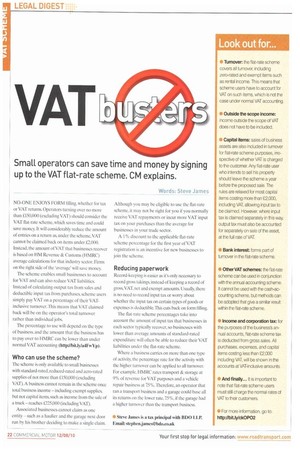Look out for...
Page 22

If you've noticed an error in this article please click here to report it so we can fix it.
• Turnover: the flat-rate scheme covers all turnover, including zero-rated and exempt items such as rental income. This means that scheme users have to account for VAT on such items, which is not the case under normal VAT accounting.
• Outside the scope income: income outside the scope of VAT does not have to be included.
• Capital items: sales of business assets are also included in turnover for flat-rate scheme purposes, irrespective of whether VAT is charged to the customer. Any flat-rate user who intends to sell his property should leave the scheme a year before the proposed sale. The rules are relaxed for most capital items costing more than £2,CCO, including VAT allowing input tax to be claimed. However, where input tax is claimed separately in this way, output tax must also be accounted for separately on sale of the asset, at the full rate of VAT • Bank interest: forms part of turnover in the flat-rate scheme.
• Other VAT schemes: the flat-rate scheme can be used in conjunction with the annual accounting scheme. It cannot be used with the cash-accounting scheme, but methods can be adopted that give a similar result within the flat-rate scheme.
• Income and corporation tax: for the purposes of the business's annual accounts, flat-rate scheme tax is deducted from gross sales. All purchases, expenses, and capital items costing less than £2,000 including VAT, will be shown in the accounts at VAT-inclusive amounts.
• And finally... It is important to note that flat-rate scheme users must still charge the normal rates of VAT to their customers.
• For more information, go to: http://bit.ly/c1c0P02








































































































































